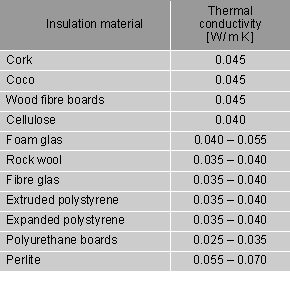Insulation materials
A well-insulated thermal envelope without thermal bridges is a passive way to obtain a low heat demand and improved thermal comfort. A certain thickness of insulation gives the largest effect if applied externally, because the largest possible numbers of cold bridges are broken. Furthermore the importance of air tightness to the heat demand and to the durability of the constructions must not be underestimated.The endeavours to reduce the heat losses of opaque elements are realised in different ways. The most used approach is the realisation of small vapours. Thermal insulation materials are therefore lightweight. The thermal conductivity of the insulation materials is close to that of a non-ventilated air space (l= 0,024 W/mK). The used materials are of various origin. Rockwool and fibreglas insulation are mineral materials, bulk insulation is mostly from volcanic origin. Polystyrene and polyurethane are synthetic

|

  
|
|
materials produced by the chemical industry. Natural insulation materials are for example cork, wood, cannabis, cellulose, cotton and sheep wool. Thermal conductivities of the different insulation materials are listed in the table on the right.Post-insulation reduces energy consumption for heating, but also cooling loads may be reduced. It can be divided into two main groups: Insulation that is mounted inside the room and outside the room.Internal post-insulation is usually done by mounting lathes on the inside of an existing construction. Insulation material is placed between the lathes and gypsum boards or wood finishes covers the insulation. The lathes can be made of wood or sometimes a metal profile is used, but in all circumstances the lathes will form a thermal bridge. Dividing the total insulation thickness into two layers can reduce the thermal bridge effect. Internal post- insulation requires a vapour barrier to be mounted on the warm side of the insulation in order to prevent diffusion of moisture to the construction. There are many disadvantages connected with post-insulation among them the following: risk of defects in the construction caused by moisture due to leakages in the vapouzr barrier, reduction of the thermal bridge effect around the floors and joints only to a limited degree, reduction of the active thermal mass of the room, thus increasing the risk of overheating due to solar radiation and the room cannot be used as long as work is in progress and the inner measures of the room will be reduced.Extra insulation layers can be mounted on the existing facade without a ventilated layer of air if it is ensured that the external insulation cladding prevents water to penetrate the constructions behind. At the same time the cladding must be sufficiently diffusion open to allow moisture diffusing into the construction from the indoor air to be drained off. Alternatively the external post-insulation can be placed with a ventilated layer of air between the insulation material and the finishing facade cladding. In this way moisture diffusing into the construction construction can be ventilated out.
|